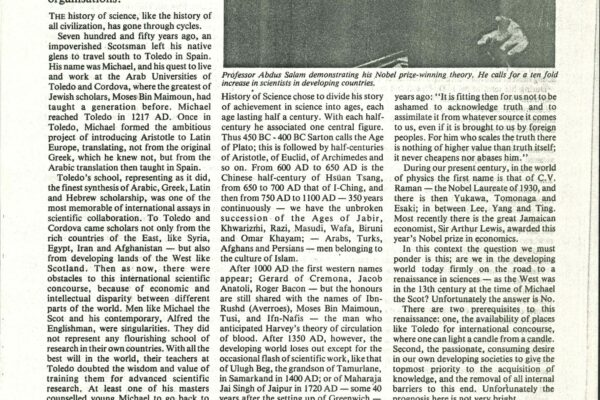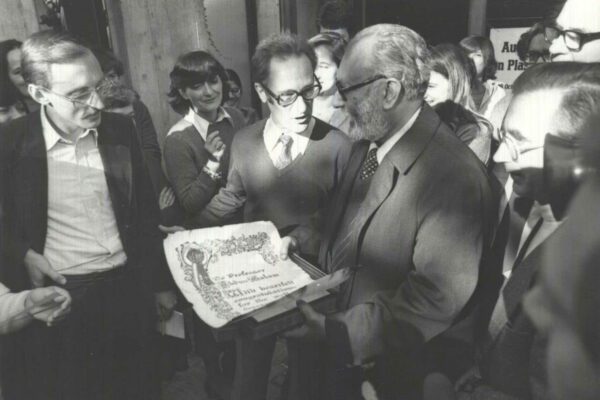Salam’s 1979 Nobel Prize
Abdus Salam, alongside Sheldon Lee Glashow and Steven Weinberg, shared the 1979 Nobel Prize in Physics “for their contributions to the theory of the unified weak and electromagnetic interaction between elementary particles, including, inter alia, the prediction of the weak neutral current”.
In separate works published throughout the 1960’s, the three physicists established a framework to unify two fundamental forces of nature at high energy: the weak nuclear force and electromagnetism.
Unifying two fundamental forces
The Standard Model of particle physics is a theory that postulates the existence of four fundamental forces of nature: electromagnetism, weak force, strong force, and gravity. Salam’s work pertains to the unification of electromagnetism and weak force.
This discovery not only shed light on fundamental questions about the evolution of the Universe since the Big Bang, but it also shed light on the Higgs field – a field that gives particles their mass.
The Standard Model
The Standard Model is the most widely accepted theory in particle physics, describing the fundamental building blocks of the universe and their interactions. It is the theory that all matter in the Universe is composed of 24 fundamental matter particles, six force carriers and one Higgs particle.
Electromagnetism governs the behaviour of charged particles, like electrons and protons. It is responsible for everything from the light we see to the functioning of our electronics.
The Weak Force is responsible for certain types of radioactive decay, such as the beta decay of a neutron into a proton, an electron, and a neutrino. Its name is derived from the fact that it acts only over tiny distances and is weaker than most of the other fundamental forces
A framework called quantum field theory (QFT) developed to explain the fundamental forces. It states that fundamental particles interact via a mediating particle which transmits a force (i.e. a force carrier). These mediators are called ‘bosons’ and are distinct from the particles that make up matter.

The Standard Model is the most widely accepted theory in particle physics, describing the fundamental building blocks of the universe and their interactions. It is the theory that all matter in the Universe is composed of 24 fundamental matter particles (purple and green), four force carriers (red) and one Higgs particle (yellow).
The science of symmetry groups
When reading about Salam’s work, you may come across the concept of symmetry groups and unitarity.
Symmetry is a fundamental idea in physics that helps us understand the way the laws of nature work. A symmetry group describes all the possible transformations that can be applied to a physical system while leaving its fundamental properties unchanged. These transformations can include things like rotations, reflections, translations, and more.
- Rotational Symmetry: Imagine a circle. If you rotate it by any angle around its center, it still looks the same. This is an example of a system with rotational symmetry.
- Mirror Symmetry: Think about a perfectly symmetrical object like a snowflake. If you look at it in a mirror, it looks the same as the original. Mirror symmetry corresponds to a reflection transformation.
- Translation Symmetry: Imagine a repeating pattern, like a checkerboard or a row of identical trees evenly spaced. If you shift the pattern to the left or right, it still looks the same.
- Time Symmetry: In physics, we often consider systems where the laws of nature don’t change over time or if we reverse time. Think about a video recording of two billiard balls hitting each other. If we were to reverse that video, our scientific description of the forces governing their collision would remain the same.
Symmetry is important to physicists because we want the rules that govern the interactions of nature to be the same, no matter what viewpoint you look at them!

The pursuit of unification

Grand Unified Theory posits that at extremely high temperatures and energies, like at the beginning of time, all four fundamental forces are merge into one force.
Throughout history, scientists have observed that seemingly distinct forces or phenomena could sometimes be described as manifestations of a single, more fundamental entity. For instance, in the 19th century, electricity and magnetism were unified into the single theory of electromagnetism by James Clerk Maxwell.
Some theoretical physicists believe that if we rewind the clock, all the distinct forces of nature were actually ruled by one grand, unified force, but something caused it to separate into the four forces we see now.
Early work that unified electromagnetism and weak force were developed by Salam and John Ward, as well as Sheldon Glashow. The theories posited the existence of force carriers known as the W+, W- and Z bosons.
However, a problem was that these bosons needed to have mass, which seemed to violate very important symmetries in physics.
In 1968, Abdus Salam, alongside Steven Weinberg, proposed a solution to this problem. What if electromagnetism and the weak force combine to form one electro-weak field with four massless bosons? At low temperatures, the symmetry that governs this electro-weak field is broken by the Higgs field, a field that gives particles mass when they interact with it.
This breaking leaves us with an independent massless field for electromagnetism, and a massive field for the weak force bosons.
The early Universe was very hot, but cooled over time. Salam and his colleagues posited that the electroweak symmetry breaking occurred at temperatures below 10^15 Kelvin (about one trillionth of a second after the Big Bang).
View our Exhibition Collection
Explore archival documents and photos, provided by the International Centre for Theoretical Physics.
















